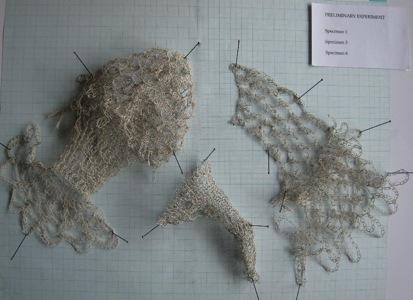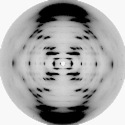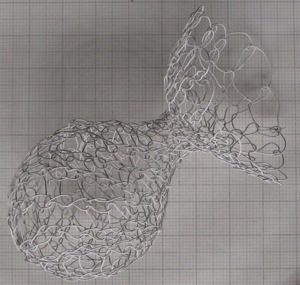experiment
The Experiments
16/11/07 18:53 Filed in: The Experiments
The work takes the form of a series of experiments exploring the idea of mutation to evolve new textile ‘life forms’. The principles of generative art are used to create a series of rules that determine the shape and form of organic 'specimens'. Variables of size, shape, sequence and number have aleatory values, ie. generated randomly.
Series 1 - Display
18/12/07 12:42 Filed in: Testing Process
Series 1 - Conclusions
17/12/07 00:53 Filed in: Testing Process
The resulting specimens show a lot of variation.
The diagrams are also interesting. An element of interpretation of the pattern variables is required in drawing up the patterns, and then further interpretation in the making process.
The diagrams are also interesting. An element of interpretation of the pattern variables is required in drawing up the patterns, and then further interpretation in the making process.
Naturally, the 3D forms that have arisen are more organic and resemble creatures than the flat 2D ones. I need to gear the next series of experiments towards three dimensionality. One method would be to introduce modular forms into the randemiser.
The diagrams remind me of xray crystallography of DNA – they exhibit more of a pattern when viewed at a much reduced scale.
Evolutionary Experiment - Codes
19/11/07 20:30 Filed in: The Experiments
Evolutionary Experiment - Variation
18/11/07 20:05 Filed in: The Experiments
Textile process - crochet - knit - needlelace
Stitch - will vary according to process
Form - start with sphere – disk – tube – spiral – pyramid
Dimensions - number of stitches – rows - iterations
Materials
Colour
Surface modifications
picot – spike – loop – frill – ridge
hole – indentation – raised
found objects
wax – paint – varnish
Each variable will have either a discreet series or range of values eg. rows / stitches will have values with upper / lower limits, while process will have values of knit, crochet or needlelace.
The preliminary experiment will confirm or modify the variables and their values. Sampling might be part or a complete specimen, enough to see what works.
Stitch size and tools (hook / needlesize) will be determined by the sampler.
Stitch - will vary according to process
Form - start with sphere – disk – tube – spiral – pyramid
Dimensions - number of stitches – rows - iterations
Materials
Colour
Surface modifications
picot – spike – loop – frill – ridge
hole – indentation – raised
found objects
wax – paint – varnish
Each variable will have either a discreet series or range of values eg. rows / stitches will have values with upper / lower limits, while process will have values of knit, crochet or needlelace.
The preliminary experiment will confirm or modify the variables and their values. Sampling might be part or a complete specimen, enough to see what works.
Stitch size and tools (hook / needlesize) will be determined by the sampler.
Evolutionary Experiment - Ideas
17/11/07 19:24 Filed in: The Experiments
Ideas – genetics, dna, mutation, inheritance, natural selection, evolution
Rules – variables such as technique (process?), dimensions, form, pattern with discreet limits
Mutation – Chance – random generator of values for rules
Genetic code – assign codes to stitch types, diagrammatic interpretations of pattern
Selection – viability and aesthetic choices
Evolution – selected specimens as starting point for next generation
Classification – identify relationships, naming
Documentation – pattern, stages of development (photography)
Rules – variables such as technique (process?), dimensions, form, pattern with discreet limits
Mutation – Chance – random generator of values for rules
Genetic code – assign codes to stitch types, diagrammatic interpretations of pattern
Selection – viability and aesthetic choices
Evolution – selected specimens as starting point for next generation
Classification – identify relationships, naming
Documentation – pattern, stages of development (photography)
Series 2 - Conclusions
29/01/08 23:41 Filed in: Testing Materials
A good strong and very open structure was produced in Specimen 6 using the fine wire and freely looping with a crochet hook. This could be used to create very small specimens, where knitting needles could not be manipulated.
The telephone wire needlelace used for Specimen 7 was very tough to work on this scale and could not be knitted or crocheted, but also the banding created a mottled pattern that was not appropriate. The Bamboo paper yarn knitted and crocheted in Specimens 8 and 9 did not have enough body to retain a form, and created too opaque a fabric.
The telephone wire needlelace used for Specimen 7 was very tough to work on this scale and could not be knitted or crocheted, but also the banding created a mottled pattern that was not appropriate. The Bamboo paper yarn knitted and crocheted in Specimens 8 and 9 did not have enough body to retain a form, and created too opaque a fabric.
In Specimen 1 and 2, the finest coated wire at 0.2mm does not have the strength to hold form using crochet and produces a floppy fabric. Specimen 3 is more successful using knitting with fine needles to produce a denser fabric, while still retaining an element of transparency. This will be required to interpret layering. The gel yarn used for Specimen 4 proved difficult – its tackiness making it stick to the needles and itself and causing the sphere to implode. A favourite material, fine paper string, was used for Specimen 5, but couldn’t hold the sphere shape on this scale and the fabric produced was too opaque.
Have chosen to work with the fine coated wire (0.25 and 0.31mm gauge) using knitting and free looping, for it’s ability to hold form and degree of transparency which will interpret layering. Crochet produces too textured a surface in the wire which distracts from the forms. The wire has a ‘springiness’ which brings the organic specimens to life.
Series 2 - Experiment with Materials
28/01/08 22:33 Filed in: Testing Materials
In this series, I have tried out various materials, using appropriate techniques. My intention is to restrict the materials used in later Series, in order to concentrate on form but at the same time add an element of uniformity.
I have taken a very basic modular shape of a cone and sphere joined by a short tube, as exhibited in Specimen 6 of Series 1.
I have taken a very basic modular shape of a cone and sphere joined by a short tube, as exhibited in Specimen 6 of Series 1.















